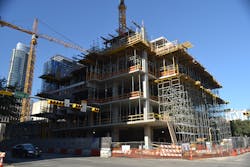Construction spending on projects under way in the first three quarters of 2018 topped the same period in 2018 by 5.5%. Spending growth was well balanced among residential, private nonresidential and public projects.
Construction employment climbed by 4.9% from October 2017 to October 2018. That growth rate was nearly triple the 1.7% increase in total nonfarm payroll employment, a sign that contractors are busy now and expect to remain busy in the near future.
In fact, contractors probably would have taken on even more workers if they could have found them. There were 278,000 job openings in construction at the end of September, the highest September total since the Bureau of Labor Statistics began estimating this number 18 years ago, and a 55% jump from the September 2017 figure of 179,000.
In a survey the Associated General Contractors of America released in late August, more than three-fourths of the 2,552 firms expect to add workers over the coming year. However, an even higher percentage of respondents said that hourly craft positions are hard to fill, and most said they expect it will be as hard or harder to fill both craft and salaried positions next year.
That expectation appears well founded. There are few experienced workers available: the unemployment rate for jobseekers with recent construction experience dropped to 3.6% in October, the lowest October rate in a series dating to 2000. Even the pool of workers without experience is growing more slowly, as the number of retirements rises and the number of new workforce entrants—either domestic or foreign-born—flattens or shrinks. And the competition from other sectors for workers has stiffened, as the unemployment rate for all adults has fallen to a 49-year low.
Materials costs have become an even bigger concern than labor availability or quality for some contractors. In 2018, tariffs were imposed with little notice on steel, aluminum, lumber and a wide variety of Chinese imports. Domestic suppliers matched many of these increases or even raised prices in anticipation of them, putting a squeeze on contractors that had signed fixed-price contracts for projects before buying materials.
Some contractors may have been insulated from the tariffs in 2018 if they had already ordered materials or were buying from suppliers that held the line on items they had in inventory. But if the tariffs stay in place, as currently appears likely, more of those price increases will be passed through to contractors. Meanwhile, some projects may be canceled as owners find their costs have risen or they have been shut out of export markets in retaliation for tariffs imposed by the U.S.
Rising interest rates are a third source of uncertainty for 2019. Most contractors do not have to arrange financing, but homebuyers, developers and municipal-bond issuers are all sensitive to interest rates. If rates rise more than is currently anticipated, more and more projects may fall by the wayside.
Single-family homebuilders are especially vulnerable to these threefold threats. More than nonresidential contractors, homebuilders rely on foreign-born workers and thus are affected by immigration policies that reduce their ranks. Single-family housing, especially in the West, uses most of the imported lumber in the nation. And homebuilders, along with their customers, are exposed to rising interest rates.
However, to the extent that households are priced out of buying homes, they are likely to rent more or pricier housing. That will add to demand for multifamily construction in 2019.
Despite the threats from labor market tightness, tariffs and rising interest rates, most contractors should find opportunities abound in 2019. The best prospects among building types appear to be in airport terminals, warehouses, data centers, and a return to growth in multifamily construction.
Ken Simonson is chief economist for Associated General Contractors.
About the Author
Ken Simonson
Chief Economist
Ken Simonson is chief economist for Associated General Contractors (AGA).
